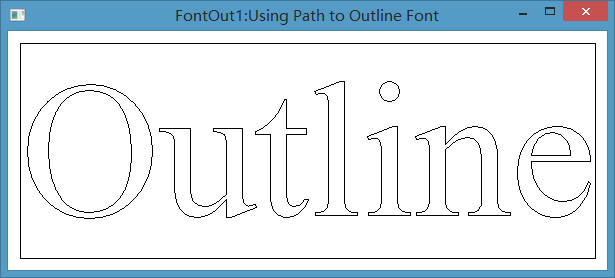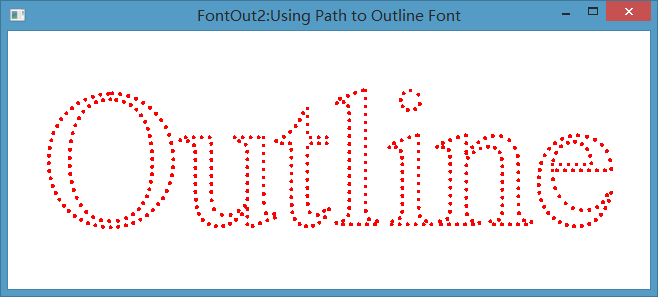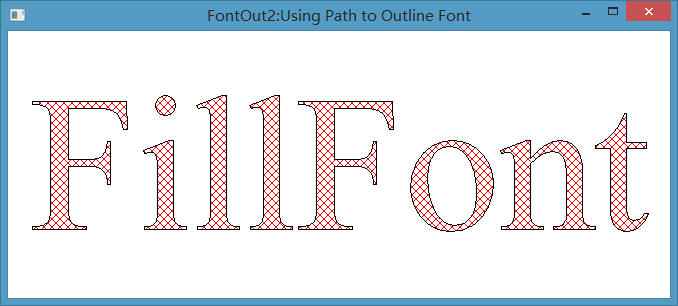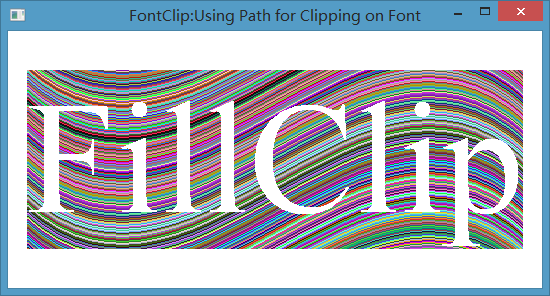17.6.1 GDI路径
(1)路径的创建
BeginPath(hdc);
//1、使用任何绘制线的函数在DC上绘制,被存在GDI内部,但不显示出来。
//2、可以在当前路径中创建一个新的子路径,其中每个子路径都是一系列互相连接的线。
//3、每个子路径可以是闭合的,也可以是开放的。要闭合子路径时,可以用CloseFigure将子路径闭合,必要时会自动添加一条直线以达到些目的。其后用任何画线函数创建的都是新的子路径。
EndPath(hdc);
(2)五个与路径有关的函数(注意:下面的函数在用完之后,都会删除被定义的路径!)
①StokePath(hdc):用当前画笔来绘制出路径出来。
②FillPath(hdc):用当前画刷,根据当前的多边形填充模式填充,会先闭合开放的路径。
③StrokeAndFillPath(hdc):一次性完成StrokePath和FillPath的功能。
④hRgn = PathToRegion(hdc);将路径转换成区域,会先闭合开放的路径。
⑤SelectClipPath(hdc,iCombine): 选择当前的路径作为设备环境的一个裁剪区域。
其中的iCombine指明的路径与当前的裁剪区域如何合并。
(3)路径:对填充与裁剪来说,路径比区域更灵活,因为区域只能由矩形、椭圆和多组合组合来定义,但路径可用包括贝塞尔曲线或弧线定义。
(4)在GDI中,路径和区域的存储截然不同,路径是由一个直线和曲线定义的集合,而区域是一个扫描线的集合。
17.6.2 扩展画笔:hPen = ExtCreatePen(dwStyle, dwWidth,&lplb,0,NULL);
|
参数 |
含义 |
|
DWORD dwStyle |
画笔的类型。与CreatePen函数的画笔类型一样,此外,还可以使用 1、画笔类型:PS_GEOMETRIC、PS_COSMETIC等类型。 2、线端点样式: ①PS_ENDCAP_ROUND:圆形 ②PS_ENDCAP_SQUARE:方形,线的长度向外延伸了出宽度的一半。 ③PS_ENDCAP_FLAT:平面样式 3、线与线连接点的样式 ①PS_JOIN_ROUND:圆形 ②PS_JOIN_BEVEL:斜截,将连接点的末端切断 ③PS_JOIN_MITER:斜接,连接点是个尖端。 |
|
DWORD dwWidth |
画笔的宽度。PS_COSMETIC宽度必须是1。 |
|
LOGBRUSH* lplb |
画笔的属性。在CreatePen中,该参数是颜色。但扩展画笔函数中,这个参数是画刷,可能为PS_GEOMETRIC样式的内部着色。这个画笔甚至可以是点阵位图。 |
|
DWORD dwStyleCount |
自定义样式数组的元素个数 |
|
DWORD *lpStyle |
自定义的样式数组 |
【EndJoin程序】

第一个V:端点、连接点都为圆形;
第二个V:端点方形、连接点斜截 ;
第三个V:端点平面、连接点斜接;
/*------------------------------------------------------------ ENDJOIN.C -- Ends and Joins Demo (c) Charles Petzold, 1998 ------------------------------------------------------------*/ #include <windows.h> LRESULT CALLBACK WndProc(HWND, UINT, WPARAM, LPARAM); int WINAPI WinMain(HINSTANCE hInstance, HINSTANCE hPrevInstance, PSTR szCmdLine, int iCmdShow) { static TCHAR szAppName[] = TEXT("EndJoin"); HWND hwnd; MSG msg; WNDCLASSEX wndclass; wndclass.style = CS_HREDRAW | CS_VREDRAW; wndclass.cbSize = sizeof(WNDCLASSEX); wndclass.lpfnWndProc = WndProc; wndclass.cbClsExtra = 0; wndclass.cbWndExtra = 0; wndclass.hInstance = hInstance; wndclass.hIcon = LoadIcon(hInstance, szAppName); wndclass.hIconSm = LoadIcon(hInstance, szAppName); wndclass.hCursor = LoadCursor(NULL, IDC_ARROW); wndclass.hbrBackground = (HBRUSH)GetStockObject(WHITE_BRUSH); wndclass.lpszMenuName = NULL; wndclass.lpszClassName = szAppName; if (!RegisterClassEx(&wndclass)) { MessageBox(NULL, TEXT("This program requires Windows NT!"), szAppName, MB_ICONERROR); return 0; } hwnd = CreateWindow(szAppName, // window class name TEXT("Ends and Joins Demo"), // window caption WS_OVERLAPPEDWINDOW, // window style CW_USEDEFAULT, // initial x position CW_USEDEFAULT, // initial y position CW_USEDEFAULT, // initial x size CW_USEDEFAULT, // initial y size NULL, // parent window handle NULL, // window menu handle hInstance, // program instance handle NULL); // creation parameters ShowWindow(hwnd, iCmdShow); UpdateWindow(hwnd); while (GetMessage(&msg, NULL, 0, 0)) { TranslateMessage(&msg); DispatchMessage(&msg); } return msg.wParam; } LRESULT CALLBACK WndProc(HWND hwnd, UINT message, WPARAM wParam, LPARAM lParam) { static int iEnd[] = { PS_ENDCAP_ROUND, PS_ENDCAP_SQUARE, PS_ENDCAP_FLAT }; static int iJoin[] = { PS_JOIN_ROUND, PS_JOIN_BEVEL, PS_JOIN_MITER }; static int cxClient, cyClient; HDC hdc; PAINTSTRUCT ps; static LOGBRUSH lb; switch (message) { case WM_CREATE: lb.lbStyle = BS_SOLID; lb.lbColor = RGB(128, 128, 128); lb.lbHatch = 0; return 0; case WM_SIZE: cxClient = LOWORD(lParam); cyClient = LOWORD(lParam); return 0; case WM_PAINT: hdc = BeginPaint(hwnd, &ps); SetMapMode(hdc, MM_ANISOTROPIC); SetWindowExtEx(hdc, 100, 100, NULL); SetViewportExtEx(hdc, cxClient, cyClient, NULL); for (int i = 0; i < 3; i++) { SelectObject(hdc, ExtCreatePen(PS_SOLID | PS_GEOMETRIC | iEnd[i] | iJoin[i], 10, &lb, 0, NULL)); BeginPath(hdc); //用扩展画笔画出来。 MoveToEx(hdc, 10 + 30 * i, 25, NULL); LineTo(hdc, 20 + 30 * i, 75); LineTo(hdc, 30 + 30 * i, 25); EndPath(hdc); StrokePath(hdc); DeleteObject(SelectObject(hdc, GetStockObject(BLACK_PEN))); //写宽度为1为画笔写出3个V MoveToEx(hdc, 10 + 30 * i, 25, NULL); LineTo(hdc, 20 + 30 * i, 75); LineTo(hdc, 30 + 30 * i, 25); } EndPaint(hwnd, &ps); return 0; case WM_DESTROY: PostQuitMessage(0); return 0; } return DefWindowProc(hwnd, message, wParam, lParam); }
17.6.3 四个范例程序
(1)FontOut1程序
①定义路径:
BeginPath(hdc);
TextOut(…); //此处是在定义的路径,并不会在GDI中立即显示出来
EndPath(hdc)
②StrokePath(hdc); //用当前画笔描边路径
③默认的文本背景模式是OPAQUE,所以文本框和字符轮廓都是路径的一部分。
【FontOut1程序】

/*------------------------------------------------ FONTOUT1 —— Using Path to Outline Font (c) Charles Petzold,1998 -------------------------------------------------*/ #include <windows.h> #include "EzFont.h" TCHAR szAppName[] = TEXT("FontOut1"); TCHAR szTitle[] = TEXT("FontOut1:Using Path to Outline Font"); void PaintRoutine(HWND hwnd, HDC hdc, int cxArea, int cyArea) { static TCHAR szString[] = TEXT("Outline"); HFONT hFont; SIZE size; //创建144磅的字体 hFont = EzCreateFont(hdc, TEXT("Times New Roman"), 1440, 0, 0, TRUE); SelectObject(hdc, hFont); GetTextExtentPoint32(hdc, szString, lstrlen(szString), &size); //开始绘制路径,但保存在GDI内部,并不在DC上显示出来 BeginPath(hdc); //在中间位置显示出来 //注意:输出文本包含两个部分,1个是文本框,一个是字符部分,所有在默认的SetBkMode(OPAQUE)模式 //下,文本框的边框也会被当成一条路径来画,因此该示例用画笔描边路径后会有一个边框,也就是 //文本框的轮廓也得了路径的一部分。 TextOut(hdc, (cxArea - size.cx) / 2, (cyArea - size.cy) / 2, szString, lstrlen(szString)); EndPath(hdc); StrokePath(hdc); //用当前画笔描边路径 SelectObject(hdc, GetStockObject(SYSTEM_FONT)); DeleteObject(hFont); }
//FontTest.c
/*------------------------------------------------------------ FONTTEST.C -- Test of FONT (c) Charles Petzold, 1998 ------------------------------------------------------------*/ #include <windows.h> #include "EzFont.h" LRESULT CALLBACK WndProc(HWND, UINT, WPARAM, LPARAM); extern TCHAR szAppName[]; extern TCHAR szTitle[]; void PaintRoutine(HWND hwnd, HDC hdc, int cxArea, int cyArea); int WINAPI WinMain(HINSTANCE hInstance, HINSTANCE hPrevInstance, PSTR szCmdLine, int iCmdShow) { HWND hwnd; MSG msg; WNDCLASSEX wndclass; wndclass.style = CS_HREDRAW | CS_VREDRAW; wndclass.cbSize = sizeof(WNDCLASSEX); wndclass.lpfnWndProc = WndProc; wndclass.cbClsExtra = 0; wndclass.cbWndExtra = 0; wndclass.hInstance = hInstance; wndclass.hIcon = LoadIcon(hInstance, szAppName); wndclass.hIconSm = LoadIcon(hInstance, szAppName); wndclass.hCursor = LoadCursor(NULL, IDC_ARROW); wndclass.hbrBackground = (HBRUSH)GetStockObject(WHITE_BRUSH); wndclass.lpszMenuName = NULL; wndclass.lpszClassName = szAppName; if (!RegisterClassEx(&wndclass)) { MessageBox(NULL, TEXT("This program requires Windows NT!"), szAppName, MB_ICONERROR); return 0; } hwnd = CreateWindow(szAppName, // window class name szTitle, // window caption WS_OVERLAPPEDWINDOW, // window style CW_USEDEFAULT, // initial x position CW_USEDEFAULT, // initial y position CW_USEDEFAULT, // initial x size CW_USEDEFAULT, // initial y size NULL, // parent window handle NULL, // window menu handle hInstance, // program instance handle NULL); // creation parameters ShowWindow(hwnd, iCmdShow); UpdateWindow(hwnd); while (GetMessage(&msg, NULL, 0, 0)) { TranslateMessage(&msg); DispatchMessage(&msg); } return msg.wParam; } LRESULT CALLBACK WndProc(HWND hwnd, UINT message, WPARAM wParam, LPARAM lParam) { HDC hdc; PAINTSTRUCT ps; static int cxClient, cyClient; switch (message) { case WM_SIZE: cxClient = LOWORD(lParam); cyClient = HIWORD(lParam); return 0; case WM_PAINT: hdc = BeginPaint(hwnd, &ps); PaintRoutine(hwnd, hdc, cxClient, cyClient); EndPaint(hwnd, &ps); return 0; case WM_DESTROY: PostQuitMessage(0); return 0; } return DefWindowProc(hwnd, message, wParam, lParam); }
//EzFont.h
/*---------------------------------------------------------- EZFONT.H header file ------------------------------------------------------------*/ #pragma once #include <windows.h> //iDeciPtHeight:字体高度:(单位1/10磅)如,12磅字体时,iDeciPtHeight=120 //iDecPtWidth:字体宽度(与上面单位一样) //iAttributes:字体属性,如粗、斜、下划线、删除线等 //fLogRes:是否使用逻辑分辨率 HFONT EzCreateFont(HDC hdc, TCHAR* szFaceName, int iDeciPtHeight, int iDeciPtWidth, int iAttributes, BOOL fLogRes); #define EZ_ATTR_BOLD 1 #define EZ_ATTR_ITATIC 2 #define EZ_ATTR_UNDERLINE 4 #define Ez_ATTR_STRIKEOUT 8
//EzFont.c
/*------------------------------------------------------------- EZFONT.C -- Easy Font Creation (c) Charles Petzold, 1998 -------------------------------------------------------------*/ #include <windows.h> #include <math.h> #include "EzFont.h" HFONT EzCreateFont(HDC hdc, TCHAR* szFaceName, int iDeciPtHeight, int iDeciPtWidth, int iAttributes, BOOL fLogRes) { HFONT hFont; LOGFONT lf; TEXTMETRIC tm; FLOAT cxDpi, cyDpi; POINT pt; SaveDC(hdc); //设置高级图形模式,此模式下可以通过矩阵实现逻辑坐标到设备坐标的转换。 SetGraphicsMode(hdc, GM_ADVANCED); ModifyWorldTransform(hdc, NULL, MWT_IDENTITY); //恢复变换到初始状态 SetViewportOrgEx(hdc, 0, 0, NULL); SetWindowOrgEx(hdc, 0, 0, NULL); if (fLogRes) { //使用逻辑分辨率(单位:像素/英寸) cxDpi = (FLOAT)GetDeviceCaps(hdc, LOGPIXELSX); cyDpi = (FLOAT)GetDeviceCaps(hdc, LOGPIXELSY); } else { //实际的分辨率(单位:像素/英寸) cxDpi = (FLOAT)(25.4 * GetDeviceCaps(hdc, HORZRES) / GetDeviceCaps(hdc, HORZSIZE)); cyDpi = (FLOAT)(25.4 * GetDeviceCaps(hdc, VERTRES) / GetDeviceCaps(hdc, VERTSIZE)); //vertsize单位为mm } //求出指定磅值的字体,需要多少像素点 pt.x = (int)(iDeciPtWidth* cxDpi / 72); //像素大小(设备单位) pt.y = (int)(iDeciPtHeight* cyDpi / 72); //像素大小(设备单位) DPtoLP(hdc, &pt, 1); //将像素大小由设备单位转为逻辑单位,也就是字体在逻辑坐标系中的大小 lf.lfHeight = -(int)(fabs(pt.y) / 10.0 + 0.5); //加0.5是为了向上取整 lf.lfWidth = 0; //注意这里要先设0,因为系统根据lfHeight匹配字体,会得到其固有的width //而iDeciPtWidth会因高级图形模式允许对字体进行拉伸和缩放。 lf.lfEscapement = 0; lf.lfOrientation = 0; lf.lfWeight = iAttributes & EZ_ATTR_BOLD ? 700 : 0; lf.lfItalic = iAttributes & EZ_ATTR_ITATIC ? 1 : 0; lf.lfUnderline = iAttributes& EZ_ATTR_UNDERLINE ? 1 : 0; lf.lfStrikeOut = iAttributes& Ez_ATTR_STRIKEOUT ? 1 : 0; lf.lfCharSet = DEFAULT_CHARSET; //默认字符集 lf.lfOutPrecision = 0; lf.lfClipPrecision = 0; lf.lfQuality = 0; lf.lfPitchAndFamily = 0; lstrcpy(lf.lfFaceName, szFaceName); hFont = CreateFontIndirect(&lf); if (iDeciPtWidth != 0) { hFont = (HFONT)SelectObject(hdc, hFont); //选入,并返回旧字体 GetTextMetrics(hdc, &tm); //获取新字体信息 DeleteObject(SelectObject(hdc, hFont));//将旧的选入,交并删除新的字体 //字体的被左右拉伸,能这样实现的前提是设为高级图形模式,即SetGraphicsMode(hdc, GM_ADVANCED); lf.lfWidth = (int)(tm.tmAveCharWidth*fabs(pt.x) / fabs(pt.y) + 0.5); hFont = CreateFontIndirect(&lf); } RestoreDC(hdc, -1); return hFont; }
(2)FontOut2程序
①使用ExCreatePen创建的画笔,而不是默认的画笔来描边路径
②本例创建一个宽3 个像素(1/24英寸)的红色虚线画笔
③也可以给路径填充颜色或图案(用FillPath或StrokeAndFillPath函数)
【FontOut2程序】

/*------------------------------------------------ FONTOUT2 —— Using Path to Outline Font (c) Charles Petzold,1998 -------------------------------------------------*/ #include <windows.h> #include "..\FontOut1\EzFont.h" TCHAR szAppName[] = TEXT("FontOut2"); TCHAR szTitle[] = TEXT("FontOut2:Using Path to Outline Font"); void PaintRoutine(HWND hwnd, HDC hdc, int cxArea, int cyArea) { static TCHAR szString[] = TEXT("Outline"); HFONT hFont; SIZE size; LOGBRUSH lb; //创建144磅的字体 hFont = EzCreateFont(hdc, TEXT("Times New Roman"), 1440, 0, 0, TRUE); SelectObject(hdc, hFont); SetBkMode(hdc, TRANSPARENT); //设置为透明背景,则文本框(含轮廓线将不被创建) GetTextExtentPoint32(hdc, szString, lstrlen(szString), &size); //开始绘制路径,但保存在GDI内部,并不在DC上显示出来 BeginPath(hdc); //在中间位置显示出来 //注意:本例SetBkMode(hdc,TRANSPARENT)为透明模式,所以只有字符的轮廓,而没有文本框的轮廓 TextOut(hdc, (cxArea - size.cx) / 2, (cyArea - size.cy) / 2, szString, lstrlen(szString)); EndPath(hdc); lb.lbColor = RGB(255, 0, 0); lb.lbStyle = BS_SOLID; lb.lbHatch = 0; SelectObject(hdc, ExtCreatePen(PS_GEOMETRIC | PS_DOT, GetDeviceCaps(hdc, LOGPIXELSY) / 24, &lb, 0, NULL)); //创建3像素的点线 StrokePath(hdc); //用当前画笔描边路径 DeleteObject(SelectObject(hdc, GetStockObject(BLACK_PEN))); SelectObject(hdc, GetStockObject(SYSTEM_FONT)); DeleteObject(hFont); }
//EzFont.h、EzFont.c、FontTest.c与本节中的FontOut1程序相同。
(3)FillFont程序
①使用默认画笔绘制路径轮廓,用HS_DIAGCROSS样式创建红色阴影线填充
②创建路径时,设置背影为TRANSPARENT。即路径只保存字符的轮廓,不保留文本框的轮廓。
③描边并填充路径时,使用OPAQUE模式,因为路径内部的区域,其要用阴影线填充。
④注意:当路径转为区域时,会根据将路径包围的范围,划分成若干个区域。如本例中当绘制路径并设置为OPAQUE里,整个文本框内部并被文字划分成若干个区域,若干个区域的并集就是文本框的大小。所以当本例中第1个SetBkMode被注释掉,也就是默认的OPAQUE时,则填充区域视多边形的填充模式而定,如果设为WINDING模式,则填充整个文本框,若设为ALTERNATE,则填充文本框内部除去字符以外的部分。
【FillFont程序】

/*------------------------------------------------ FONTFILL —— Using Path to Fill Font (c) Charles Petzold,1998 -------------------------------------------------*/ #include <windows.h> #include "..\FontOut1\EzFont.h" TCHAR szAppName[] = TEXT("FontOut2"); TCHAR szTitle[] = TEXT("FontOut2:Using Path to Outline Font"); void PaintRoutine(HWND hwnd, HDC hdc, int cxArea, int cyArea) { static TCHAR szString[] = TEXT("FillFont"); HFONT hFont; SIZE size; //创建144磅的字体 hFont = EzCreateFont(hdc, TEXT("Times New Roman"), 1440, 0, 0, TRUE); SelectObject(hdc, hFont); //设置为透明背景,则文本框(含轮廓线将不被创建) SetBkMode(hdc, TRANSPARENT); //如果该句被注释掉,则路径中包含文本框和字符轮廓 GetTextExtentPoint32(hdc, szString, lstrlen(szString), &size); //开始绘制路径,但保存在GDI内部,并不在DC上显示出来 BeginPath(hdc); //在中间位置显示出来 //注意:本例SetBkMode(hdc,TRANSPARENT)为透明模式,所以只有字符的轮廓,而没有文本框的轮廓 TextOut(hdc, (cxArea - size.cx) / 2, (cyArea - size.cy) / 2, szString, lstrlen(szString)); EndPath(hdc); //创建带阴影线的画刷 SelectObject(hdc, CreateHatchBrush(HS_DIAGCROSS, RGB(255, 0, 0))); SetBkMode(hdc, OPAQUE); //SetPolyFillMode(hdc, WINDING); //默认的填充模式为ALTERNATE(交替)填充 //当第1个SetBkMode为OPAQUE,而此处为WINDING //时,会填充整个文本框(含字符内部),如果 //为ALTERNATE,则填充文本框内部除(字符的部分) //当第1个SetBkMode为TRANSPARENT时,不管此处为 //WINDING还是ALTERNATE,则只填充字体内部区域。 StrokeAndFillPath(hdc); //用默认画笔描边,并用刚创建的画刷填充路径。 DeleteObject(SelectObject(hdc, GetStockObject(WHITE_BRUSH))); SelectObject(hdc, GetStockObject(SYSTEM_FONT)); DeleteObject(hFont); }
(4)FontClip程序
①先用TextOut画出路径,再将路径通过SelectClipPath设为裁剪区域
②如果绘制路径时,将SetBkMode设为TRANSPARENT,则区域为字体轮廓的内部。如果设为OPAQUE,则区域为整个文本框。
【FontClip程序】

/*------------------------------------------------ FONTCLIP —— Using Path for Clipping on Font (c) Charles Petzold,1998 -------------------------------------------------*/ #include <windows.h> #include "..\FontOut1\EzFont.h" TCHAR szAppName[] = TEXT("FontClip"); TCHAR szTitle[] = TEXT("FontClip:Using Path for Clipping on Font"); void PaintRoutine(HWND hwnd, HDC hdc, int cxArea, int cyArea) { static TCHAR szString[] = TEXT("FillClip"); HFONT hFont; SIZE size; int y, iOffset; POINT pt[4]; //创建120磅的字体 hFont = EzCreateFont(hdc, TEXT("Times New Roman"), 1200, 0, 0, TRUE); SelectObject(hdc, hFont); //设置为透明背景,则文本框(含轮廓线将不被创建) //SetBkMode(hdc,TRANSPARENT); //如果该句被注释掉,则路径中包含文本框和字符轮廓 GetTextExtentPoint32(hdc, szString, lstrlen(szString), &size); //开始绘制路径,但保存在GDI内部,并不在DC上显示出来 BeginPath(hdc); //在中间位置显示出来 //注意:本例SetBkMode(hdc,TRANSPARENT)为透明模式,所以只有字符的轮廓,而没有文本框的轮廓 TextOut(hdc, (cxArea - size.cx) / 2, (cyArea - size.cy) / 2, szString, lstrlen(szString)); EndPath(hdc); //将路径设为裁剪区域 //SetPolyFillMode(hdc, WINDING); SelectClipPath(hdc, RGN_COPY); //1、如果SetBkMode(OPAQUE),当WINDING模式时,则整个文本框为裁剪区域 //设为ALTERNATE时,则文本框除文字部分以外的区域为裁剪区域 //2、如果SetBkMode(TRANSPARENT),不管是ALTERNATE或WINDING模式, //裁剪区域均为字符内部的区域。(与上面FontFill程序的原理是一样的。) //绘制Bezier样条线 iOffset = (cxArea + cyArea) / 4; for (y = -iOffset; y < cyArea + iOffset; y++) { pt[0].x = 0; pt[0].y = y; pt[1].x = cxArea / 3; pt[1].y = y + iOffset; pt[2].x = 2 * cxArea / 3; pt[2].y = y - iOffset; pt[3].x = cxArea; pt[3].y = y; SelectObject(hdc, CreatePen(PS_SOLID, 1, RGB(rand() % 256, rand() % 256, rand() % 256))); PolyBezier(hdc, pt, 4); DeleteObject(SelectObject(hdc, GetStockObject(BLACK_PEN))); } SelectObject(hdc, GetStockObject(SYSTEM_FONT)); DeleteObject(hFont); }
//EzFont.h、EzFont.c、FontTest.c与本节中的FontOut1程序相同。